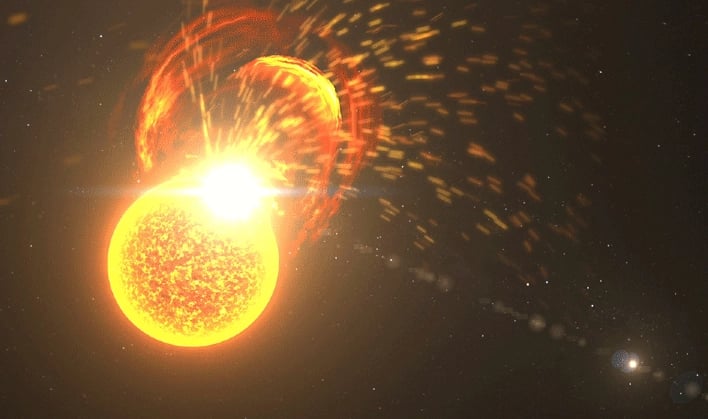Enormous Explosion From Young Sun-Like Star Has Scientists Concerned About Earth

On December 7, NASA launched two new pieces of technology aboard the Atlas V rocket. One of those was the UVSC Pathfinder whose mission will be to study the origins of solar energetic particles (SEPs) in order to be able to better predict when they may occur. NASA wants to know this information because of the possibility of SEPs passing through a spacecraft causing damage to electronics, and even an astronaut's skin with the possibility of changing their DNA. These particles are considered to be the Sun's most dangerous form of radiation. So, when astronomers witness a coronal mass ejection, sometimes called a solar storm, being emitted from a younger star than our own, eyes and ears perk up.
Solar storms happen on a regular basis on our own Sun. They consist of clouds of extremely hot particles known as plasma that can travel through space at breakneck speeds of millions of miles per hour. Yuta Notsu of the University of Colorado Boulder said, "Coronal mass ejections can have a serious impact on Earth and human society." If one of these mass ejections were to make a direct impact with Earth it could fry satellites in orbit and knock out the power grids to entire cities. This would more than likely cause mass hysteria here on Earth.
The information that was collected by the group of researchers was performed in the winter and spring of 2020. Researchers observed the star EK Draconis, a star that is about the same size as our own Sun and a youngling at just 100 million years old. Notsu added, "It's what our sun looked like 4.5 billion years ago."
The group observed the star for 32 nights and on April 5th, they got fortunate when EK Draconis erupted into a really big superflare. Just 30 minutes later, they observed what they believe to be have been a coronal mass ejection hurtling away from the star's surface. The team was only able to view the first stage known as the filament eruption phase. But even with it being just the first phase, it was moving at a top speed of approximately 1 million miles per hour.

Researchers note that huge mass ejections could have been much more common in the early years of the solar system. They think that gigantic coronal mass ejections may have played a large role in shaping planets like Earth and Mars into what we see today. Notsu said, "The atmosphere of present-day Mars is very thin compared to Earth's. In the past, we think that Mars had a much thicker atmosphere. Coronal mass ejections may help us to understand what happened to the planet over billions of years."
There is much we are still uncertain about when it comes to things like how the Earth came to be what it is today and the phenomena that exists throughout the solar system that could shape the Earth's future. But as astronomers, scientists and researchers continue to unlock more of the galaxy's mysteries, hopefully that information will be able to give us a better idea of what we have to look forward to.

